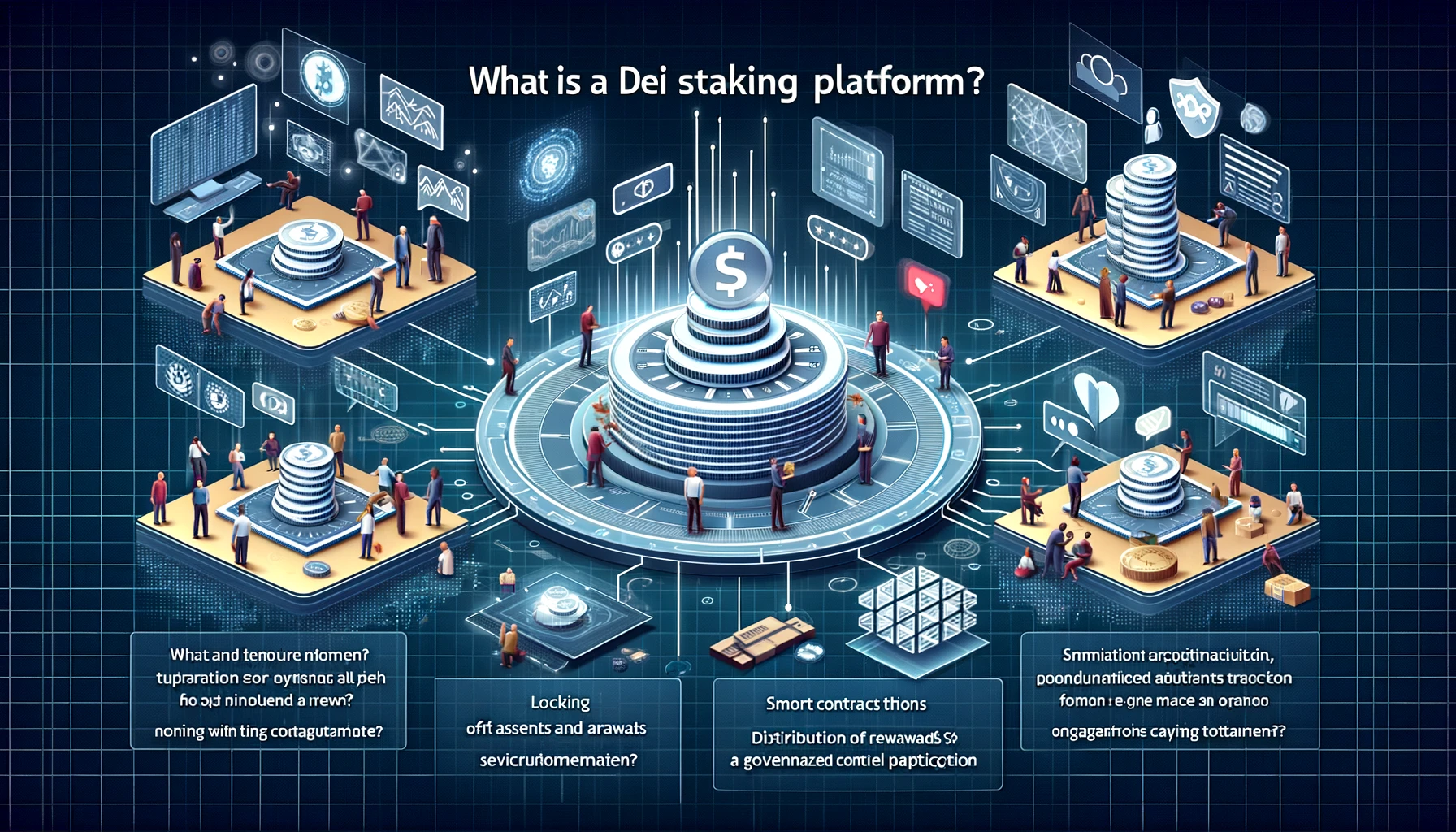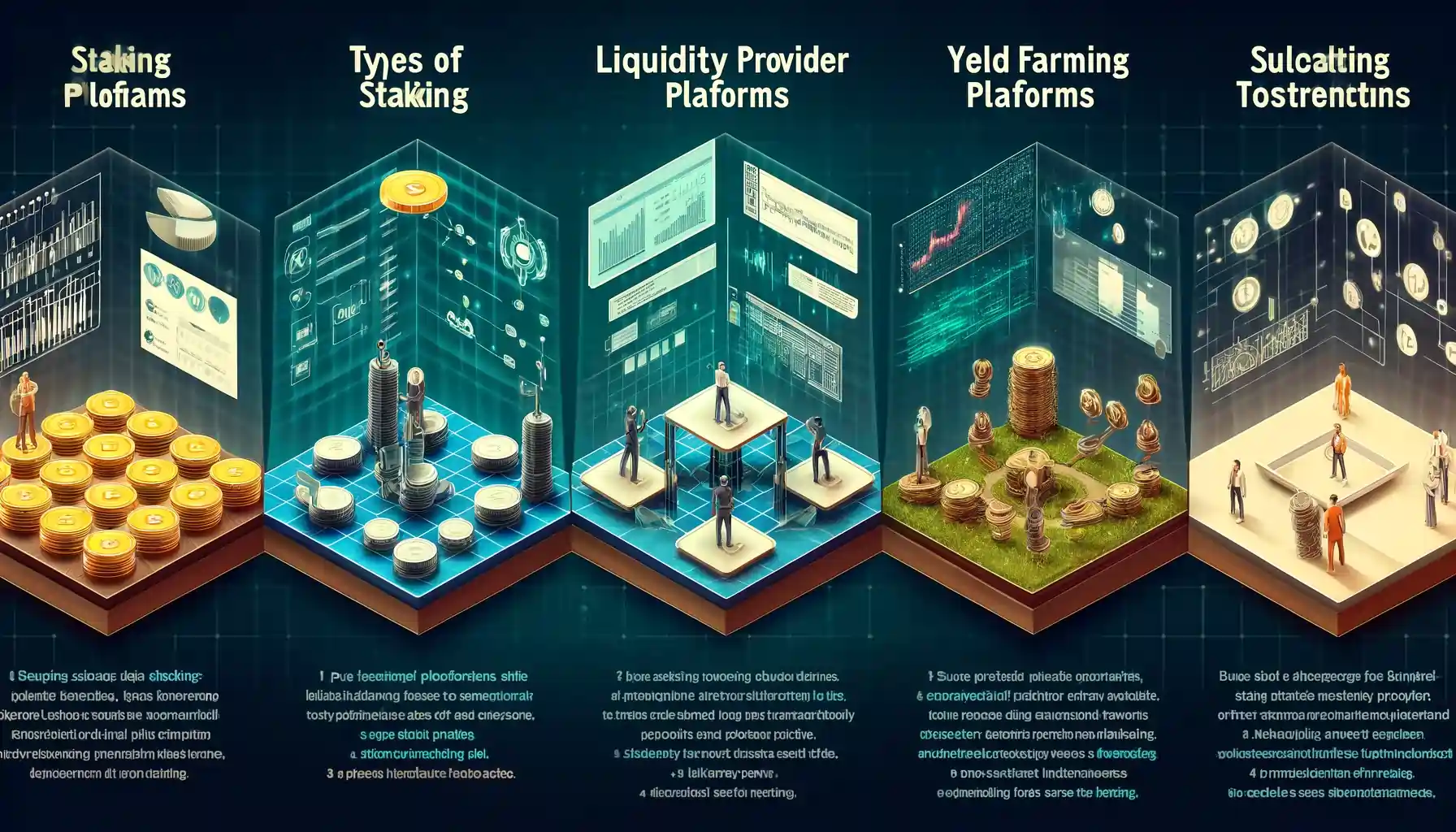Introduction
If you haven’t heard about it yet, you’ve clearly not kept your finger on the crypto and DeFi pulse.
Decentralized Finance (DeFi) represents a shift from traditional, centralized financial systems to peer-to-peer finance enabled by decentralized technologies built on Ethereum and other blockchain networks.
A crucial component of this ecosystem is DeFi staking, an innovative way to earn passive income by participating in network security and other related activities.
This article will dive into what DeFi staking platforms are, how they function, and the benefits they offer to users.

Understanding DeFi Staking
What is DeFi Staking?
DeFi staking refers to the process of locking up cryptocurrencies in a DeFi protocol to support the network’s operations and security. In return, stakers receive rewards, often in the form of additional cryptocurrency.
In other words, you stake some ETH to earn some ETH.
This concept is fundamental to many DeFi platforms, as it provides the necessary security and functionality to decentralized networks.
Components of DeFi Staking
Let’s look at what DeFi staking is made up of and what you need to pay attention to
Staking Pools: Users often pool their resources to increase their chances of earning rewards and reduce the volatility of their returns. Staking pools are managed via smart contracts, ensuring transparency and security without the need for a central authority.
Staking Rewards: Rewards are distributed to stakers as an incentive to lock their funds and support the network. The size and frequency of these rewards can depend on the amount staked, the length of time the assets are staked, and the overall network conditions.
Staking Tokens: Many DeFi platforms issue their own tokens, which are used within the ecosystem to facilitate various operations, including staking. Holders of these tokens can stake them to participate in network governance, secure the network, and earn staking rewards.
By participating in DeFi staking, users contribute to the robustness and efficiency of the decentralized financial system while generating potential earnings for themselves.
This foundational knowledge sets the stage for exploring DeFi staking platforms in more detail, particularly how they utilize these components to offer various staking opportunities.

What is a DeFi Staking Platform?
A DeFi staking platform is a type of defi platform that specializes in offering staking services among other features like trading, lending, and borrowing.
It allows users to lock their crypto assets to support network operations and earn staking rewards.
These platforms function on blockchain networks and employ smart contracts to automate the staking process, ensuring transparency and reliability without centralized control.
Core Functions of DeFi Staking Platforms:
- Locking of Assets: Participants deposit cryptocurrencies, which are then locked in smart contracts. These staked assets are used to sustain network operations, validate transactions, and enhance blockchain security.
- Distribution of Rewards: Staking platforms automatically distribute rewards based on set rules. These rewards typically come in the form of additional tokens or a portion of transaction fees, incentivizing participants to stake their digital assets.
- Governance Participation: Many platforms enable token holders to partake in governance decisions, using their staked tokens to vote on key issues that dictate the platform’s development and operational rules.

Types of DeFi Staking Platforms
DeFi staking platforms vary widely in structure and offered features, catering to different user needs and objectives:
- Pure Staking Platforms: These platforms are dedicated solely to staking services. Users can earn rewards by simply staking their tokens to support network functions.
- Liquidity Provider Platforms: These platforms combine staking with liquidity provision. Participants contribute to liquidity pools, facilitating trading on decentralized exchanges and earning fees from trades in addition to staking rewards.
- Yield Farming Platforms: Involve more complex strategies where users stake assets across various protocols to optimize returns, often engaging with multiple tokens and platforms.

Key Features of DeFi Staking Platforms
Security Measures
One of the paramount concerns in DeFi staking is the robust security measures employed by these platforms to protect user assets and ensure the integrity of staking operations.
DeFi platforms utilize advanced cryptographic techniques and smart contracts to automate and secure processes.
This infrastructure minimizes the risk of human error and fraud, safeguarding staked assets and the staking rewards they generate.
Key Security Features:
- Decentralized Operations: By operating on a decentralized blockchain network, these platforms reduce the risk of centralized points of failure, which can be susceptible to attacks.
- Smart Contract Audits: Regular audits by third-party security firms ensure that the smart contracts that manage staking, rewards distribution, and governance are free from vulnerabilities.
- Multi-Signature Wallets: Some platforms require multiple signatures for critical transactions, enhancing security by distributing the approval process among trusted parties.
Earning Passive Income through Staking
DeFi staking platforms offer a compelling method to earn passive income by staking digital assets in return for rewards.
These rewards are typically derived from transaction fees generated by the network or other incentive mechanisms designed by the DeFi protocol.

Ways to Earn Passive Income
- Staking Rewards: Users receive rewards based on the amount of crypto assets they stake and the duration of their investment. These rewards serve as an incentive to secure the network and participate in its operations.
- Yield Farming and Liquidity Mining: Some platforms offer additional earning opportunities through yield farming, where users can engage in complex strategies involving multiple liquidity pools to maximize their returns.
- Governance Tokens: Often, participants in DeFi staking platforms receive governance tokens, which not only represent a stake in the platform but also provide voting rights that can have monetary value.

Benefits of Using DeFi Staking Platforms
Advantages of DeFi Staking
DeFi staking platforms play a pivotal role in the decentralized finance ecosystem, offering users a dual opportunity: to contribute to network security and earn passive income.
When users lock their digital assets into a staking platform, they are rewarded with staking rewards, creating a steady income stream that doesn’t require active trading or management.
This practice not only incentivizes participation but also underpins the security and integrity of the blockchain network by ensuring a distributed, robust validation process.

Accessibility and Flexibility
One of the standout features of DeFi staking platforms is their inclusivity. They are crafted to cater to a wide audience—from novice individuals dabbling in cryptocurrencies to seasoned investors looking for sophisticated strategies.
This accessibility is bolstered by features like flexible staking periods, which let participants choose the duration of their investment, ranging from short-term holdings to more extended commitments.
Moreover, the integration of liquidity pools allows stakers to contribute to the liquidity of decentralized exchanges, simultaneously earning transaction fee rewards. This variety of options means that users can tailor their staking strategies to fit their specific financial goals and risk profiles.
Technological Innovation
At the heart of DeFi staking platforms is a commitment to technological advancement.
These platforms leverage smart contracts to automate and secure all operations, from reward distribution to governance decisions, ensuring transparency and reducing human error.
Furthermore, the advent of yield farming on some platforms offers enhanced earning potential by dynamically reallocating assets between different liquidity pools to capitalize on the best available rewards.
Additionally, the introduction of cross-chain staking options marks a significant innovation, broadening the scope for earning opportunities and risk diversification across multiple blockchain environments.
Through these innovations, DeFi staking platforms are not just passive income venues; they are active participants in pushing the envelope of what decentralized finance can achieve.
Their growing popularity underscores their capability to blend security, profitability, and user empowerment into a single, unified platform.

Choosing the Right DeFi Staking Platform
Choosing the best DeFi staking platform requires understanding the unique features and safety protocols each platform offers. This decision can impact not only the potential returns but also the risk level involved.
Factors to Consider When Selecting a DeFi Staking Platform
Selecting the right platform involves careful consideration of several factors that ensure the platform’s alignment with your financial goals and risk tolerance.
Security Measures
The foundation of any reliable DeFi staking platform is its security infrastructure. Look for platforms that employ robust security measures, including regular audits, secure smart contract implementations, and user-friendly security practices.
These elements are crucial for protecting staked assets and ensuring that the platform can defend against both internal and external threats.

Reputation and Transparency
A platform’s reputation within the decentralized finance community can be a significant indicator of its reliability and performance.
Platforms that maintain transparent operations and have a history of fair practices are generally more trustworthy.
Supported Assets
Different platforms support various crypto assets for staking. Choose a platform that supports the digital assets you own and wish to stake.
The diversity of supported assets can also affect the liquidity and overall stability of the platform.
Reward Structure and Terms
Understanding how and when staking rewards are paid out is vital. Some platforms offer higher staking rewards, but these might come with longer lock-up periods or higher risks.
Competitive staking rewards should be evaluated in the context of these conditions to ensure they meet your income goals and liquidity needs.

How to Get Started with DeFi Staking
Getting started with DeFi staking involves a series of steps that can help potential stakers understand the process, maximize their earnings, and minimize risks.
This guide will also touch upon some less frequently discussed yet crucial elements like the types of supported assets and flexible staking periods.
Setting Up for Staking
Before diving into staking, it’s important to choose a platform that not only offers competitive staking rewards but also aligns with your staking goals and risk tolerance.
- Select a Platform: Start by researching the best DeFi staking platforms, looking specifically at those that have a strong reputation for security and performance. Ensure the platform supports the crypto assets you intend to stake and that it operates under a DeFi protocol known for its robustness.
- Create and Secure Your Account: Once you choose a platform, set up your account. Implement security measures such as two-factor authentication, and ensure your private keys are stored securely.
Participating in Staking
After setting up your account, you can begin the staking process. This involves several key actions that range from choosing your staking options to understanding the staking mechanisms involved.
- Deposit Your Assets: Transfer the digital assets you want to stake to your platform’s wallet. Check for the minimum amount required and any potential transaction fees that might apply.
- Choose Your Staking Option: Many platforms offer different staking pools and programs. Decide if you want to participate in a more traditional staking pool, engage in yield farming, or provide liquidity to earn additional rewards.
- Understand the Terms: Familiarize yourself with the terms of your staking agreement, including lock-up periods, expected returns, and any conditions that might affect your staking income.

Optimizing Your Staking Strategy
To make the most out of your staking activities, consider a few strategic approaches that can enhance your returns and provide better control over your investments.
- Flexible Staking Periods: Some platforms offer flexible staking periods that allow you to adjust the duration of your staking based on market conditions or personal financial needs.
- Reinvesting Rewards: To capitalize on the power of compounding, reinvest your staking rewards. This can significantly increase your potential returns over time.
- Diversifying Your Portfolio: To mitigate risks, diversify your staked assets across different DeFi platforms and staking programs. This can also expose you to a wider range of staking rewards and reduce the impact of poor performance from any single asset or platform.
Staying Informed and Adapting
The DeFi landscape is rapidly evolving, with new platforms and staking options emerging regularly. Keeping informed about DeFi staking platform development, changes in DeFi protocols, and trends in decentralized finance can help you adapt your strategies to maximize returns and ensure safety.
- Stay Updated: Follow industry news, participate in community discussions, and regularly review the performance and security updates of your chosen platforms.
- Evaluate Performance: Regularly assess the performance of your staked assets. If a platform or asset no longer meets your criteria, consider realigning your strategy to maintain optimal performance.

Conclusion
DeFi staking platforms have established themselves as pivotal components of the decentralized finance landscape. They offer compelling opportunities for earning passive income while enhancing the security and efficiency of blockchain networks.
As these platforms continue to evolve, they promise even greater accessibility and profitability, attracting a wider range of participants from casual investors to serious financial strategists.
The future of DeFi staking looks bright, with advancements expected in security, user experience, and integration of diverse crypto assets.
For anyone looking to dive into decentralized finance, staking presents a robust entry point with the potential for significant returns and the opportunity to contribute to the pioneering world of blockchain technology.
Other articles we thought you would find useful
- Mastering Defi Security: Everything You Need to Know
- Where to Find Remote Blockchain Jobs
- What’s the next crypto airdrop?

